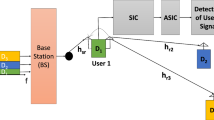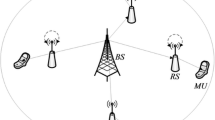Abstract
This paper describes a hybrid half duplex (HD) and full duplex (FD) user relaying cooperative non orthogonal multiple access (NOMA) system, where a HD/FD user relaying node shares the information to far users from base station (BS). The system works under residual self-interference (RSI) due to imperfect self-interference cancellation. An advanced successive interference cancellation (ASIC) scheme is introduced in the system as an alternative of successive interference cancellation (SIC) technique. The implementation of ASIC scheme in the proposed system is done by mapping the received signal into number of subgroups. Then, the conventional SIC technique is applied to each of these subgroups for decoding information signals. The performance analysis of the proposed system is comprehensively conducted through the closed form expressions, which are derived in terms of outage probability, system throughput, achievable sum rate and energy efficiency. The effectiveness and correctness of the proposed system is verified by analytical results, which clearly boost the outage performance and system throughput than traditional system in moderate to high SNR region. The robustness of the proposed system is also provided with high achievable sum rate and energy efficiency than traditional system under RSI.










Similar content being viewed by others
Data availability
The datasets are available from the corresponding author on reasonable request.
Code Availability
The code generated during the current research work are available from the corresponding author on reasonable request.
References
Luo, Q., Gao, P., Liu, Z., Xiao, L., Mheich, Z., Xiao, P., & Marref, A. (2021). An error rate comparison of power domain non-orthogonal multiple access and sparse code multiple access. IEEE Open Journal of Communication Society, 2(500–511), 2021. https://doi.org/10.1109/OJCOMS.2021.3064504
Patel, S., Chauhan, D., & Gupta, S. (2021). An overview of non orthogonal multiple access for future radio communication. In International conference on intelligent technologies, Hubli, India.https://doi.org/10.1109/CONIT51480.2021.9498336
Ghosh, J., Ra, I.-H., Singh, S., Haci, H., & Al-Utabi, K. (2022). On the comparison of optimal NOMA and OMA in a paradigm shift of emerging technologies. IEEE Access, 10, 11616–11632. https://doi.org/10.1109/ACCESS.2022.3146349
Baghani, M., Parsaeefard, S., Derakhshani, M., & Saad, W. (2019). Dynamic non-orthogonal multiple access and orthogonal multiple access in 5G wireless networks. IEEE Transactions on Communication, 67(9), 6360–6373. https://doi.org/10.1109/TCOMM.2019.2919547
Jaafar, W., Naser, S., Muhaidat, S., Sofotasios, P. C., & Yanikomeroglu, H. (2020). Multiple access in aerial networks: From orthogonal and non-orthogonal to rate-splitting. IEEE Open Journal of Vehicular Technology, 1, 372–392. https://doi.org/10.1109/OJVT.2020.3032844
Ding, Z., Liu, Y., Choi, J., Sun, Q., Elkashlan, M., Chih-Lin, I., & Poor, H. V. (2017). Application of non-orthogonal multiple access in LTE and 5G networks. IEEE Communication Magazine, 55(2), 185–191. https://doi.org/10.1109/MCOM.2017.1500657CM
Shahen Shah, A. F. M., Qasim, A. N., Karabulut, M. A., Iihan, H., & Islam, M. B. (2021). Survey and performance evaluation of multiple access schemes for next-generation wireless communication systems. IEEE Access, 9, 113428–113442. https://doi.org/10.1109/ACCESS.2021.3104509
Ding, Z., Yang, Z., Fan, P., Member, S., & Poor, H. V. (2014). On the performance of non-orthogonal multiple access in 5G systems with randomly deployed users. IEEE Signal Processing Letters, 21(12), 1501–1505. https://doi.org/10.1109/LSP.2014.2343971
Kara, F., & Kaya, H. (2018). Performances of downlink and uplink NOMA in the presence of SIC errors over fading channels. IET Communication, 12(15), 1834–1844.
Hasan, M. K., Sshahjalal, M., & Mainul, M. (2020). the role of deep learning in NOMA for 5G and beyond communications. In International conference on artificial intelligence in information and communication, Fukuoka, Japan.https://doi.org/10.1109/ICAIIC48513.2020.9065219
Ozduran, V. (2018). Advanced successive interference cancellation for non-orthogonal multiple Access. 26th Telecommunications Forum, Belgrade, Serbia. https://doi.org/10.1109/TELFOR.2018.8612111
Kim, J. B., & Lee, I. H. (2015). Non-orthogonal multiple access in coordinated direct and relay transmission. IEEE Communication Letters, 19(11), 2037–2040. https://doi.org/10.1109/LCOMM.2015.2474856
Ding, Z., Peng, M., & Poor, H. (2015). Cooperative non-orthogonal multiple access in 5G systems. IEEE Communication Letters, 19(8), 1462–1465. https://doi.org/10.1109/LCOMM.2015.2441064
Kim, J. B., & Lee, I. H. (2015). Capacity analysis of cooperative relaying systems using non-orthogonal multiple access. IEEE Communication Letters, 19(11), 1949–1952. https://doi.org/10.1109/LCOMM.2015.2472414
Men, J., Ge, J., & Zhang, C. (2017). Performance analysis of non-orthogonal multiple access for relaying networks over Nakagami-m fading channels. IEEE Transactions on Vehicular Technology, 66(2), 1200–1208. https://doi.org/10.1109/TVT.2016.2555399
Zhang, Z., Chai, X., Long, K., Vasilakos, A. V., & Hanzo, L. (2015). Full duplex techniques for 5G networks: Self-interference cancellation, protocol design, and relay selection. IEEE Communication Magazine, 53(5), 128–137. https://doi.org/10.1109/MCOM.2015.7105651
Ju, H., Oh, E., & Hong, D. (2009). Improving efficiency of resource usage in two-hop full duplex relay systems based on resource sharing and interference cancellation. IEEE Transactions Wireless Communication, 8(8), 3933–3938. https://doi.org/10.1109/TWC.2009.081049
Duarte, M., Dick, C., & Sabharwal, A. (2012). Experiment-driven characterization of full-duplex wireless systems. IEEE Transactions on Wireless Communications, 11(12), 4296–4307. https://doi.org/10.1109/TWC.2012.102612.111278
Rodriguez, L. J., Tran, N., & Le-Ngoc, T. (2014). Performance of full duplex AF relaying in the presence of residual self-interference. IEEE Journal on Selected Areas in Communications, 32(9), 1752–1764. https://doi.org/10.1109/JSAC.2014.2330151
Wang, Q., Dong, Y., Xu, X., & Tao, X. (2015). Outage probability of full-duplex AF relaying with processing delay and residual self-interference. IEEE Communication Letters, 19(5), 783–786. https://doi.org/10.1109/LCOMM.2015.2411596
Kwon, T., Lim, S., Choi, S., & Hong, D. (2010). Optimal duplex mode for DF relay in terms of the outage probability. IEEE Transactions on Vehicular Technologies, 59(7), 3628–3634. https://doi.org/10.1109/TVT.2010.2050503
Zhang, Z., Ma, Z., Xiao, M., Ding, Z., & Fan, P. (2017). Full-duplex device-to-device aided cooperative non-orthogonal multiple access. IEEE Transactions on Vehicular Technologies, 66(5), 4467–4471. https://doi.org/10.1109/TVT.2016.2600102
Yue, X., Liu, Y., Kang, S., Nallanathan, A., & Ding, Z. (2018). Exploiting full/half-duplex user relaying in NOMA systems. IEEE Transactions on Communications, 66(2), 560–575. https://doi.org/10.1109/TCOMM.2017.2749400
Zhang, L., Liu, J., Xiao, M., Wu, G., Liang, Y. C., & Li, S. (2017). Performance analysis and optimization in downlink NOMA systems with cooperative full-duplex relaying. IEEE Journal on Selected Areas in Communications, 35(10), 2398–2412. https://doi.org/10.1109/JSAC.2017.2724678
Le, Q. N., Yadav, A., Nguyen, N.-P., Dobre, O. A., & Zhao, R. (2021). Full-duplex non-orthogonal multiple access cooperative overlay spectrum-sharing networks with SWIPT. IEEE Transactions on Green Communications and Networking, 5(2), 322–334. https://doi.org/10.1109/TGCN.2020.3036026
Alharbi, T. E. A., Shen, K. Z., & Danial, K. C. (2020). Full-duplex cooperative non-orthogonal multiple access system with feasible successive interference cancellation. In Vehicular technology conference, Antwerp, Belgium.https://doi.org/10.1109/VTC2020-Spring48590.2020.9129033
Abbasi, O., Ebrahimi, A., & Mokari, N. (2019). NOMA inspired cooperative relaying system using an AF relay. IEEE Wireless Communication Letters, 8(1), 261–264. https://doi.org/10.1109/LWC.2018.2869592
Jiang, H., Shen, B., Dong, K., & Xu, H. (2021). Performance analysis of full duplex cooperative NOMA system with imperfect SIC. In IEEE Vehicular Technology Conference, Norman, OK, USA. https://doi.org/10.1109/VTC2021-Fall52928.2021.9625322
Pei, X., Wen, M., Mumtaz, S., Otaibi, S. A., & Guiza, M. (2020). NOMA-based coordinated direct and relay transmission with a half-duplex/full-duplex relay. IEEE Transactions on communications, 68(11), 6750–6760. https://doi.org/10.1109/TCOMM.2020.3017002
Funding
This research work has received no specific funds and grants from any funding agency during preparation of this manuscript.
Author information
Authors and Affiliations
Corresponding author
Ethics declarations
Conflict of interest
We declare that we have no conflict of interest.
Additional information
Publisher's Note
Springer Nature remains neutral with regard to jurisdictional claims in published maps and institutional affiliations.
Appendices
Appendix A: proof of proposition 1
For deriving the result of (19), the outage probability of user \(D_1\) can be evaluated as
where the variable \(\gamma _s{_r}\) has exponential distribution with parameter \(\lambda _s{_r}^\gamma \). Therefore,
where \(\theta _1 = \max (\tau _1,\tau _2,\tau _3)\), \(\tau _1 = \frac{\gamma _{th1}}{a_1}\), \(\tau _2 = \frac{\gamma _{th2}}{a_2} \), and \(\tau _3 = \frac{\gamma _{th3}}{(a_3-a_1\gamma _{th3})}\).
Appendix B: proof of proposition 2
The outage probability of \(D_2\) is written as
where the variable \(\gamma _r{_2}\) is an exponentially distributed random variable with parameter \(\lambda _r{_2}^\gamma \), and \(\theta _2 = (\phi _1+\phi _2)\), \(\phi _1 = \frac{1}{c_2\lambda _r{_2}^\gamma }\), and \(\phi _2 = \frac{V+N_0}{2a_2\lambda _s{_r}^\gamma }\).
Appendix C: proof of proposition 3
The outage probability of user \(D_3\) for deriving the result of (25) can be written as
where the variable \(\gamma _r{_3}\) is an exponentially distributed random variable with parameter \(\lambda _r{_3}^\gamma \), and \(\theta _3 = (\psi _1+\psi _2)\), \(\psi _1 = \frac{1}{(c_3-c_2\gamma _{th3})\lambda _r{_3}^\gamma }\), and \(\psi _2 = \frac{V+N_0}{2(a_3-a_1\gamma _{th3})\lambda _s{_r}^\gamma }\).
Rights and permissions
Springer Nature or its licensor (e.g. a society or other partner) holds exclusive rights to this article under a publishing agreement with the author(s) or other rightsholder(s); author self-archiving of the accepted manuscript version of this article is solely governed by the terms of such publishing agreement and applicable law.
About this article
Cite this article
Alvi, Q.H. Performance analysis of hybrid half and full duplex user relaying non orthogonal multiple access system with advanced successive interference cancellation. Telecommun Syst 83, 67–77 (2023). https://doi.org/10.1007/s11235-023-01010-8
Accepted:
Published:
Issue Date:
DOI: https://doi.org/10.1007/s11235-023-01010-8




